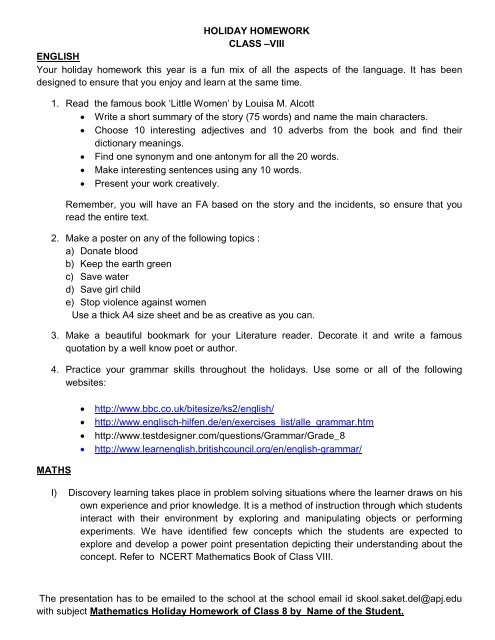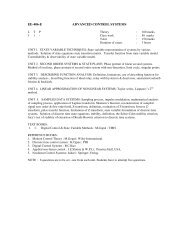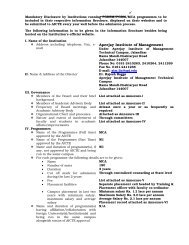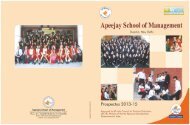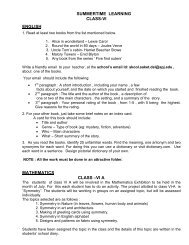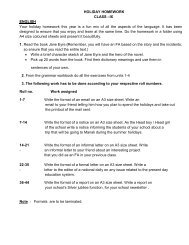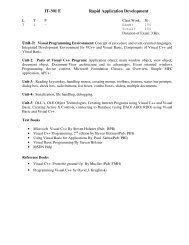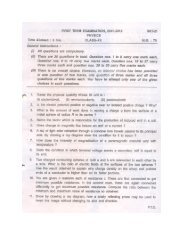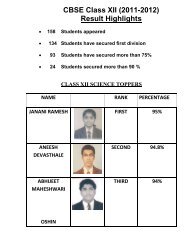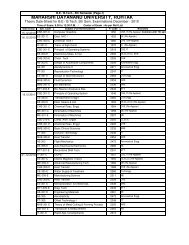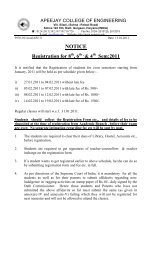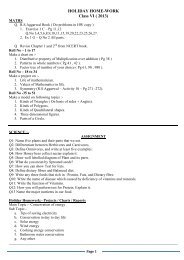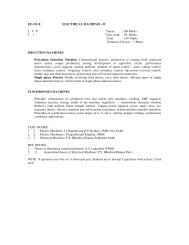HOLIDAY HOMEWORK CLASS âVIII ENGLISH Your holiday ...
HOLIDAY HOMEWORK CLASS âVIII ENGLISH Your holiday ...
HOLIDAY HOMEWORK CLASS âVIII ENGLISH Your holiday ...
- No tags were found...
Create successful ePaper yourself
Turn your PDF publications into a flip-book with our unique Google optimized e-Paper software.
<strong>HOLIDAY</strong> <strong>HOMEWORK</strong><strong>CLASS</strong> –VIII<strong>ENGLISH</strong><strong>Your</strong> <strong>holiday</strong> homework this year is a fun mix of all the aspects of the language. It has beendesigned to ensure that you enjoy and learn at the same time.1. Read the famous book ‘Little Women’ by Louisa M. Alcott Write a short summary of the story (75 words) and name the main characters. Choose 10 interesting adjectives and 10 adverbs from the book and find theirdictionary meanings. Find one synonym and one antonym for all the 20 words. Make interesting sentences using any 10 words. Present your work creatively.Remember, you will have an FA based on the story and the incidents, so ensure that youread the entire text.2. Make a poster on any of the following topics :a) Donate bloodb) Keep the earth greenc) Save waterd) Save girl childe) Stop violence against womenUse a thick A4 size sheet and be as creative as you can.3. Make a beautiful bookmark for your Literature reader. Decorate it and write a famousquotation by a well know poet or author.4. Practice your grammar skills throughout the <strong>holiday</strong>s. Use some or all of the followingwebsites:http://www.bbc.co.uk/bitesize/ks2/english/http://www.englisch-hilfen.de/en/exercises_list/alle_grammar.htmhttp://www.testdesigner.com/questions/Grammar/Grade_8http://www.learnenglish.britishcouncil.org/en/english-grammar/MATHSI) Discovery learning takes place in problem solving situations where the learner draws on hisown experience and prior knowledge. It is a method of instruction through which studentsinteract with their environment by exploring and manipulating objects or performingexperiments. We have identified few concepts which the students are expected toexplore and develop a power point presentation depicting their understanding about theconcept. Refer to NCERT Mathematics Book of Class VIII.The presentation has to be emailed to the school at the school email id skool.saket.del@apj.eduwith subject Mathematics Holiday Homework of Class 8 by Name of the Student.
Roll No. 1- 5The students will explore the properties of the different operations on rational numbers. Based ontheir study the students are expected to observe and analyse the following:“If a property for a particular operation holds for rational numbers, will it also hold for integers andwhole numbers?Roll No. 6-10The students will study different types of polygons and show the classification of polygons on thebasis of -(a) Number of sides or vertices(b)Regular or irregular polygons(c)Convex and concave polygonsRoll No. 11-15Explore the properties of interior and exterior angles of different types of polygons. Verify theproperty related to sum of the measures of exterior angles and interior angles of both convexpolygon as well as concave polygon.Roll No. 16-20Study the different types of parallelograms and list the similarities and dissimilarities betweendifferent types of parallelograms. Find the properties of different types of parallelograms .Based ontheir observations, the students are expected to explore the following:1. A square was defined as a rectangle with all sides equal. Can we define it as a rhombus withequal angles?2. A mason has made a concrete slab. Which shapes should he use to make it rectangular?Roll No. 21-25:Explain the different ways in which data can be represented graphically and find the merits anddemerits of each type of representation.Roll No. 26-30:-Study square numbers and make a list of at least seven properties of square numbers. Based onthe observation of square numbers, find out how many non square numbers are there between10 2 and 11 2 ?
Roll No. 31-36:The students will study different tests of divisibility of 2,5,10. Based on the study of divisibility,answer the following questions:1.If the division N÷5 leaves a remainder of 1, what might be the unit digit of N?2.If the division N÷2 leaves a remainder of 1,what might be the unit digit of N?3.If a number is divisible by any number m, then will it also be divisible by each of the factors of m?Roll No. 36- 44:The students will study different tests of divisibility of 3,9,11. Based on the study of divisibility,answer the following questions:1. If 21y5 is a multiple of 9, where y is a digit, what is the value of y?2. If 31z5 is a multiple of 3, where z is a digit, what might be the values of z?II) Practice your Mathematical skills by visiting the given webpage and solve questions in thefollowing links: D.1, D.2, D.3, D.4, D.5, D.6, D.7, D.8, E.I, E.2, E.3, E.4, E.5 , E.6, E.7 onhttp://www.ixl.com/math/grade-8III) Bring articles, amazing facts, riddles, cross-words, recent discoveries in the field ofMathematics for the school biannual Mathematics newsletter (minimum 2).SOCIAL SCIENCEHISTORYLet’s have some fun in History and Civics .<strong>Your</strong> Holiday Home work this year is a little differentfrom the usual work of making files etc. It provides each one of you an opportunity to display yourresearch skills. Section A will highlight the different features of ‘ The Indian Constitution’ andSection B will explore the various aspects of ‘The revolt of 1857’. Isn’t that interesting!General Instructions:1. The whole class will be divided into 7 groups.2. Each group will make a power point presentation on the topic allotted to them.3. Maximum number of slides is 10.4 Colour, Font, Text, should be appropriately used. Animations, videos and pictures could also beused.Reference: History Chapter - 4 of ‘Our Pasts’. Civics Chapter -1 The Indian Constitution.Besides this use information from other sources too. (Internet, encyclopedia, books from schoollibrary, etc.)
Section A Group One- Roll No (1 to 9)Making of the constitution-(Who made our constitution, composition of constituent assembly,key personalities, how was it made, when did it come into effect) Group two-Roll No(10 to 18)Federalism-(its meaning, why was it adopted, division of power between different levels ofgovernment, which government has more power and why?) Group three- Roll no (19 to 27)Parliamentary form of government-(definition, importance, how is the govt. formed in thissystem, how is it different from the presidential form of govt.) Group Four- Roll No (28 to 36)Separation of powers-(three organs of the government, their functions, necessity andimportance of separation of powers) Group Five – Roll No (37 to 44)Fundamental Rights-(meaning, various Fundamental Rights with examples, and theirimportance for citizens)Section BGroup 1. Adeeb Ahmed, Anish Talwar,Anjan Gupta, Anshul Nautiyal, Anubhuti,BhaskerSharma(Leader)Topic : Causes of the Revolt of 1857Political, Economic ,Social-Religious, Military and Immediate Causes of the Revolt.Group 2. Arpit Manektalia,(leader), Chaitanya Dixit , Chhainiya Lal, Disha Khattar, Hrijul Tandon,Ipsa Mishra , Irfan Khan.Topic: Nature of the Revolt of 1857Mutiny or a Popular Rebellion, ( Role of people)Group 3. Ishaan Dingra, Ishita Jain ,Ishita Kanthwal , Jahanvi Kathuria , K. Anshul (leader),Kamaksh Singh, Kartik SharmaTopic: Outbreak of the Revolt of 1857From Meerut To Delhi (events in Meerut and Delhi)Group 4. Kushboo Kohli , Parkhi Kataria , Lakshay Chaudhary , Manan Arora , Mayank Mehra(leader) , Monaal GaurTopic: Leaders of the revolt along with the areas of the revolt.Delhi, Lucknow, Kanpur, Gwalior, Arrah etc Map showing the areas.Group 5. Shubham Yadav , Neeraj Joshi , Nupur P , K .Faraj (leader) , Priyanka Sharma ,Rishab Gupta , Amogh TandonTopic: Company suppresses the revolt- places Delhi, Lucknow etcSignificance of the revolt - (Rise of feelings of nationalism, leaders who inspired thepeople)
Group 6. Ritik Chanana , Sameeksha S , Sangya , Saraansh Bansal ,Shivam Arora (leader),Shivansh BhasinTopic: Causes of the Failure of the Revolt of 1857.Lack of unity, Lack of resources, Lack of national leaders ,Revolt not widespread etcGroup 7. Mritunjay B.(leader), Sukriti Nijhawan , Sushant Chaudhary , Tanmay , Tanvi Vohra,Yuvraj SaraswatTopic : Aftermath of the RevoltImportant Changes Introduced by the British e.g. Transfer of power to the British Crown,Reorganization of the army etc.SCIENCE1. Today life without plastics cannot be imagined. Be it home or outside, plastic is everywhere.Collect information on the following plastics (Teflon, Bakelite, PVC, Melamine). Write abouttheir methods of preparation, monomer, properties and uses. Also paste pictures of any 5things each made from these plastics.2. Find out the locations of the deposits of Iron, Aluminum, Zinc, Copper and Gold in India.Mark these in an outline map of India. In which form are the deposits found? Also write theuses of these metals.3. The Science department is planning to start a Science newsletter shortly. For making thishappen bring articles, amazing facts, riddles, cross-words, recent discoveries in the field ofScience (minimum 2).4. Do the following activity and record your observation with reasons. Remove the shell from a hard boiled egg. Take an empty glass bottle with a mouth large enough through which an egg can besqueezed through without squashing it. Place the boiled egg with its small end down on the mouth of bottle. Does the egg move? Remove the egg. Burn the strips of paper and drop these burning papers quickly into the bottle. Quickly place the boiled egg once again on the mouth of the bottle. What happen to the egg?
5. Bacterial ReproductionBacteria can reproduce very quickly. If conditions are correct bacteria can divide every 20 minutes.This means a small number of bacteria can multiply very quickly.Time( Number ofmin) bacteria0 10020If 100 bacteria get into your body and reproduce every 20 minutes how manywill there be in 2 hours?406080FRENCH Project100120Make a chart on famous personalities in France. You can choose from the list belowor any other French personality of your choice.TopicsRoll No. Art: Claude Monet 1-10 History: Jeanne d’Arc/Napoleon Bonaparte 11-20 Gustave Eiffel 21-30 Zinedine Zidane 31-40 Nicolas Sarkozy 41-50 Charles de Galle Emma Watson Joan of ArcThe chart should provide answers to the following questions.What is this person famous for?What is remarkable about what they did?What difficulties or opposition did they face?What impact did have on the world at the time?Why should we remember them today?Instructions1. Draw and/or cut out pictures2. Take the help from newspapers/magazines/internet3. Add the latest information about the individual celebrity.
ात पुरकार के नाम उनक कोई एक कवतानोट - काय का मूयांकन मौलकता और वषयवतु के आधार पर कया जाएगा IBOOK CLUBReading helps you to foster empathy, morality, critical thinking, imaginations and creativity; it notonly broaden your interests, spark your passions, but also inspire you to think and do great things.Joining a book club is one of the greatest ways to develop all of these wonderful qualities. Ourschool also has a Book Club. Any student can be the member of this book club. Every month wechoose a book to read and given a month time to read it. Then we have a discussion on the bookin which anything related to the book, content or an interesting part of the book is read out.The core idea of a book club is to come to express, share . As people, we can learn thingsindependently, come up with great ideas alone, or enjoy books by ourselves. But a special feelingarises when we come together to share these experiences. It is human nature to want someone tohear what you have to say. It's empowering! It's fun! And it's what the book club is all about.During this summer vacation the book to be read is “Harry Potter and the Philosopher's Stone byJ.K. Rowling”.


